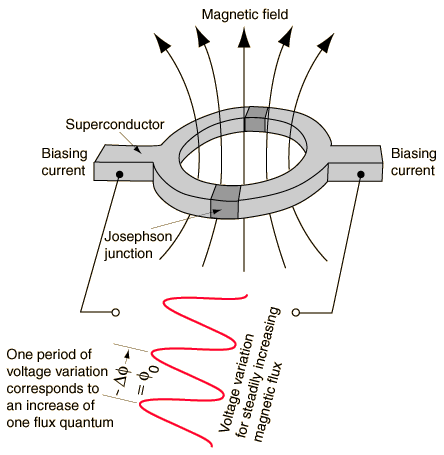As mentioned briefly in the introduction, the potential of superconductors is incredible, and their applications are practically innumerable. They promise to revolutionize electronics as we know them today: making logic gates faster, smaller, and more efficient. This will lead to a leap in miniaturization of consumer electronics and integrated circuits. At the very heart of this is Josephson Junctions, explained below.
Josephson Junctions
Josephson Junctions have already proven their worth. Recently, the accepted value of Planck's constant has changed from 6.62559 to 6.626196E-34 by experiments on Josephson Junctions measuring the voltage across the junction and the frequency of radiation.
Already widely used, SQUIDS (Superconducting Quantum Interference Device) are made from a pair of Josephson Junctions (pictured below). A biasing current is maintained in the SQUID, the voltage measured across the device oscillates with the changes in phase at the two junctions, which is dependant on the changing magnetic flux. Therefore, by counting oscillations, you can detect the flux change. Using this principle, SQUIDS can detect magnetic fields as low as 10E-14 T. Examination of Josephson Junctions like this has led to the discovery that magnetic flux is quantized.
Many properties of superconductors and Josephson Junctions make them ideal for logic gates. Perhaps foremost, such gates have been shown to have a switching time of 10ps. However, that is so fast- almost too fast- that it leads to problems- mainly because of the finite velocity of light. In such an incredibly short time interval, an electrical signal will have only traveled 3mm. This makes density of components quite important, as to minimize the distance between elements. In traditional electronics, this would create a heat dissipation problem, and since we're dealing with temperature-sensitive superconductors, this is even more of an issue. Fortunately, superconducting elements dissipate heat many orders of magnitude less than traditional electronics.
